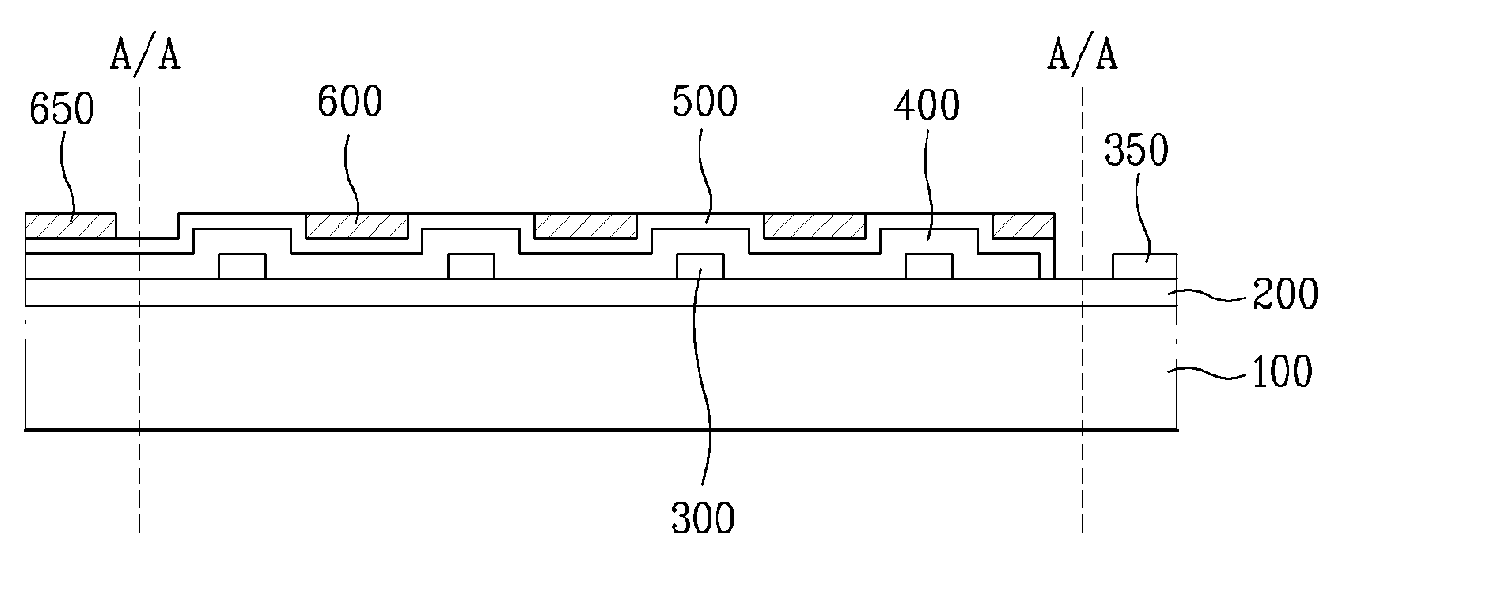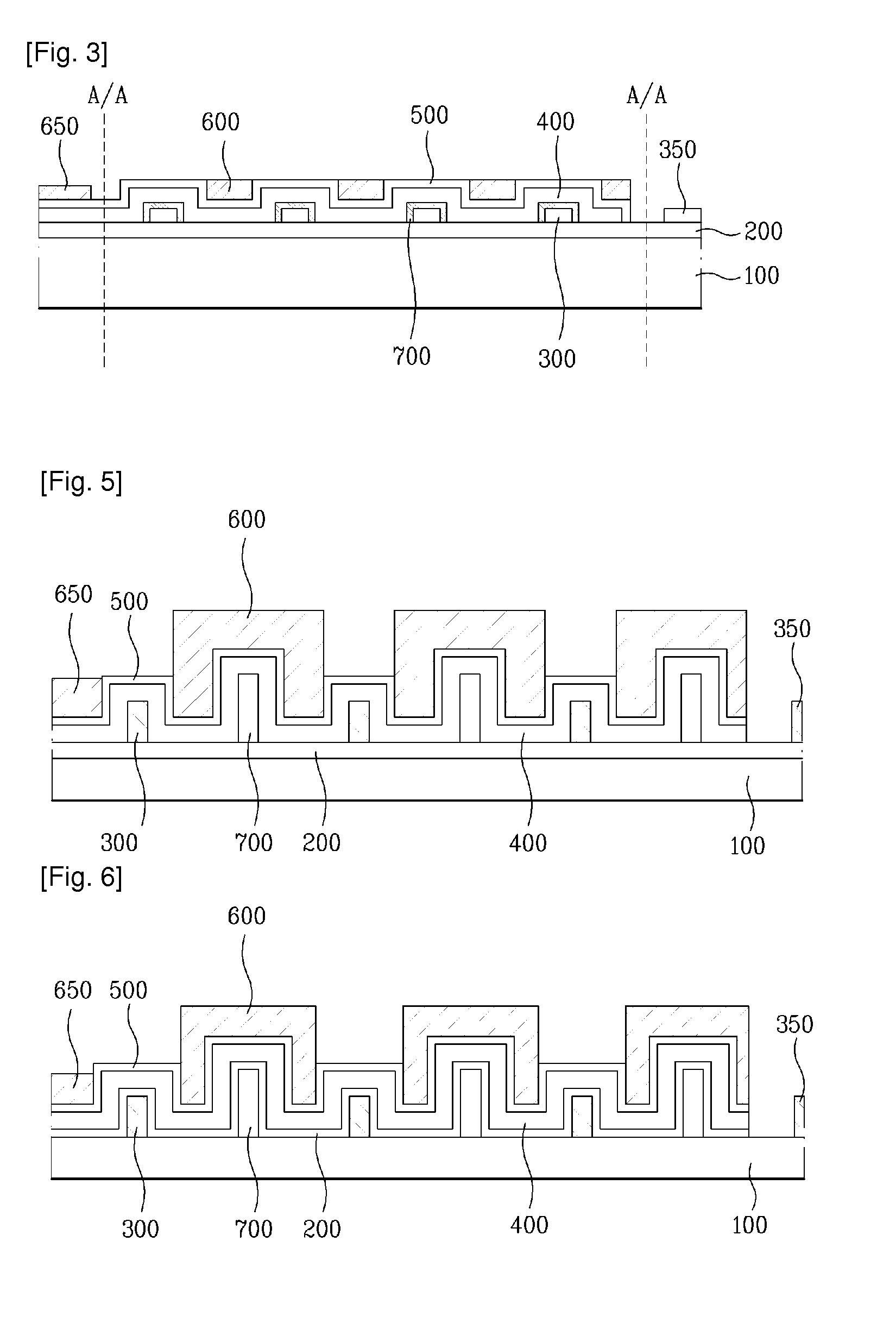Thin film type solar cell and method for manufacturing the same
- Summary
- Abstract
- Description
- Claims
- Application Information
AI Technical Summary
Benefits of technology
Problems solved by technology
Method used
Image
Examples
first embodiment
[0139]FIGS. 12A to 12E are cross section views illustrating a method for manufacturing a thin film type solar cell according to the first embodiment of the present invention.
[0140]First, as shown in FIG. 12A, the front electrode layer 200 is formed on the substrate 100.
[0141]At this time, the substrate 100 may be formed of glass or transparent plastic. The transparent conductive layer 200 may be formed of the transparent conductive material such as ZnO, ZnO:B, ZnO:Al, ZnO:H, SnO2, SnO2:F, or ITO (Indium Tin Oxide) by sputtering or MOCVD (Metal Organic Chemical Vapor Deposition).
[0142]The front electrode layer 200 may have the uneven surface through the texturing process.
[0143]As shown in FIG. 12B, the auxiliary electrode 300 is formed on the front electrode layer 200.
[0144]The auxiliary electrode 300 and the first bus line 350 are formed at the same time. At this time, the auxiliary electrode 300 is formed within the active area (A / A) of the thin film type solar cell, and the first ...
second embodiment
[0155]FIGS. 13A to 13F are cross section views illustrating a method for manufacturing a thin film type solar cell according to the second embodiment of the present invention.
[0156]First, as shown in FIG. 13A, the front electrode layer 200 is formed on the substrate 100.
[0157]Then, as shown in FIG. 13B, the auxiliary electrode 300 and the first bus line 350 connected with the auxiliary electrode 300 are formed on the front electrode layer 200.
[0158]As shown in FIG. 13C, the insulating layer 700 covers the auxiliary electrode 300, that is, the insulating layer 700 is formed on the lateral and upper surfaces of the auxiliary electrode 300.
[0159]In more detail, the insulating layer 700 is formed on the lateral and upper surfaces of first auxiliary electrode 310, second auxiliary electrodes 320a, 320b, 320c and 320d, and third auxiliary electrode 330 shown in FIGS. 8A to 8D.
[0160]The insulating layer 700 may be formed of the insulating material such as SiO2, TiO2, SiNx, SiON, or polymer...
third embodiment
[0165]FIGS. 14A to 14F are cross section views illustrating a method for manufacturing a thin film type solar cell according to the third embodiment of the present invention.
[0166]First, as shown in FIG. 14A, the front electrode layer 200 is formed on the substrate 100.
[0167]Next, as shown in FIG. 14B, the insulating layer 700 is formed on the front electrode layer 200.
[0168]The insulating layer 700 is positioned at one side of the auxiliary electrode formed during the procedure of FIG. 14C. At this time, the insulating layer 700 is formed such that the insulating layer 700 becomes higher than the auxiliary electrode 300.
[0169]As shown in FIG. 14C, the auxiliary electrode 300 and the first bus line 350 connected with the auxiliary electrode 300 are formed on the front electrode layer 200.
[0170]The auxiliary electrode 300 is positioned next to the insulating layer 700.
[0171]In the meantime, the auxiliary electrode 300 and the first bus line 350 are firstly formed, and then the insula...
PUM
 Login to View More
Login to View More Abstract
Description
Claims
Application Information
 Login to View More
Login to View More - R&D
- Intellectual Property
- Life Sciences
- Materials
- Tech Scout
- Unparalleled Data Quality
- Higher Quality Content
- 60% Fewer Hallucinations
Browse by: Latest US Patents, China's latest patents, Technical Efficacy Thesaurus, Application Domain, Technology Topic, Popular Technical Reports.
© 2025 PatSnap. All rights reserved.Legal|Privacy policy|Modern Slavery Act Transparency Statement|Sitemap|About US| Contact US: help@patsnap.com



